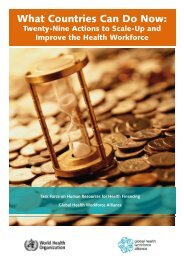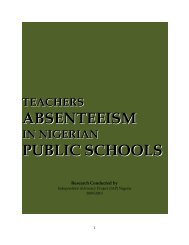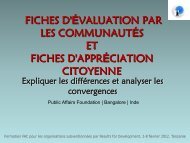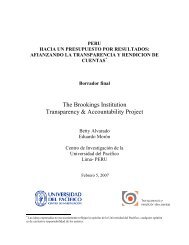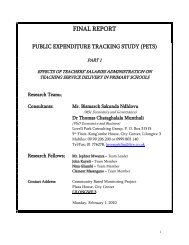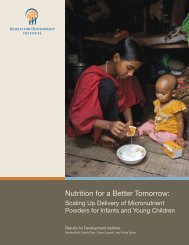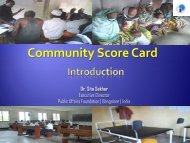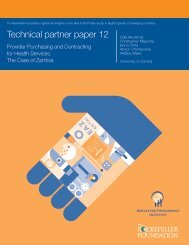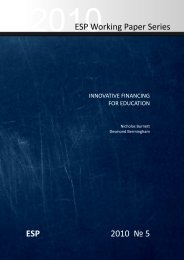Innovative Secondary Education For Skills Enhancement
Innovative Secondary Education For Skills Enhancement
Innovative Secondary Education For Skills Enhancement
You also want an ePaper? Increase the reach of your titles
YUMPU automatically turns print PDFs into web optimized ePapers that Google loves.
Section 2: <strong>Innovative</strong> Models of <strong>Secondary</strong><br />
<strong>Education</strong> In South Asia 15<br />
<strong>Education</strong> systems in South Asia still face huge challenges<br />
in providing high-quality education to millions of secondary<br />
school students, many of whom live in remote rural<br />
areas or areas frequently affected by natural disasters. In<br />
this paper’s focus countries—India, Pakistan, and Bangladesh—the<br />
scale of the challenge far exceeds anything<br />
faced by any other region of the world.<br />
In India, secondary school enrollment now exceeds 100<br />
million students. India stands far above most other countries<br />
in the region with gross secondary enrollment rates<br />
reaching 58 percent in 2009–10. But India, like the other<br />
countries in the region, faces continuing problems in raising<br />
the standard of learning in secondary schools; ensuring<br />
a steady supply of high-quality and well-trained teachers;<br />
and finding programs that provide secondary education<br />
to large numbers of the urban and rural poor and other<br />
marginalized communities such as scheduled castes and<br />
tribes. India has recognized the need to stimulate innovation<br />
in the sector by establishing an innovation fund that<br />
provides incentives to state governments and public and<br />
private education providers.<br />
In Pakistan, there are more than 24,000 high schools, of<br />
which nearly 60 percent are in the private sector. The<br />
government of Pakistan made a major shift in education<br />
policy in the mid-1990s and started involving the private<br />
sector and civil society organizations in the financing,<br />
management, and delivery of education services. This<br />
move was officially recognized by the <strong>Education</strong> Sector<br />
Reform Action Plan, 2001–2005, which stated that the<br />
government was unable to singlehandedly manage the education<br />
sector and thus actively encouraged public–private<br />
partnerships as a critical innovative strategy for expansion<br />
and effective delivery of education in Pakistan.<br />
Bangladesh, like other South Asian countries, has seen<br />
the number of teachers in secondary school significantly<br />
increase over the past decade, to 210,000 in 2010. However,<br />
only just over half of those teachers are formally<br />
trained. In its education policy, Bangladesh is committed<br />
to improving the management and quality of education<br />
administration at all levels, and puts particular emphasis<br />
on public–private partnership and the role of non-state<br />
providers in improving access, participation, and excellence<br />
in secondary education.<br />
This section summarizes a selection of promising innovations<br />
in the South Asia region that are improving education<br />
delivery at the secondary level (see Table 2), and that<br />
may also offer lessons for other countries struggling to<br />
deal with similar demographic challenges.<br />
Innovations to Improve<br />
Existing Systems<br />
The government of India has embarked on a massive<br />
program of expanding and strengthening secondary education<br />
in India, pioneered by the Rashtriya Madhyamik<br />
Shiksha Abhiyan (“<strong>Secondary</strong> <strong>Education</strong> for All”) program.<br />
Building on a similar program at the elementary level,<br />
the government aims to universalize access to secondary<br />
education by opening additional schools, appointing more<br />
teachers, and upgrading elementary schools.<br />
To achieve this ambitious goal, the government has<br />
acknowledged that it will need to work in partnership<br />
with a range of private and nongovernment providers to<br />
promote innovative approaches to delivering high-quality<br />
secondary education and skills development, in particular<br />
to the poor and scheduled tribes. Many of the programs<br />
working to improve existing systems in India, therefore,<br />
are either run by or in close consultation with the Indian<br />
government. Programs include innovative financing mechanisms,<br />
re-imagined schooling models, creative use of<br />
technology for educational administration, and teaching.<br />
Rashtriya Madhyamik<br />
Shiksha Abhiyan (India)<br />
The Rashtriya Madhyamik Shiksha Abhiyan (RMSA)<br />
(“<strong>Secondary</strong> <strong>Education</strong> for All”) program, a country-wide<br />
secondary education development program, is implemented<br />
in partnership with states and union territories<br />
and aims to make secondary education of good quality<br />
available, accessible, and affordable to all young persons<br />
aged 15 to 16 years, while also removing gender, socioeconomic,<br />
and other barriers by 2017. It also aims to make<br />
all secondary schools conform to the prescribed norms<br />
relating to infrastructure, teaching and nonteaching staff,<br />
and the teaching–learning environment.<br />
15 This section draws heavily on Mohanty and Zaidi (2012).<br />
44 <strong>Innovative</strong> <strong>Secondary</strong> <strong>Education</strong> <strong>For</strong> <strong>Skills</strong> <strong>Enhancement</strong> (ISESE)



